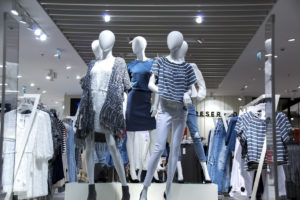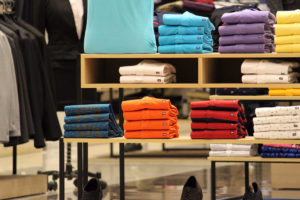 Could it be that Santa Claus is not always a jolly, giving man? Oh yeah. Take a look at this Santa. He (or I guess it could be a she) is out for a little cheer for…. himself. Regardless who they are, customers need to be watched. In this case, the store let their guard down because of the costume. Shoplifters use deception and costumes to steal.
Could it be that Santa Claus is not always a jolly, giving man? Oh yeah. Take a look at this Santa. He (or I guess it could be a she) is out for a little cheer for…. himself. Regardless who they are, customers need to be watched. In this case, the store let their guard down because of the costume. Shoplifters use deception and costumes to steal.
In this case, the Santa costume allows plenty of room to hide merchandise. Shoplifters will make or modify clothing to become a shoplifting tool. We call these “booster” items. Booster coats, dresses, skirts, pants and more. I have even seen booster “bloomers”. They are worn under a loose fitting skirt or dress. The shoplifter drops a merchandise item through what looks like a pocket in the outer garment and into the bloomers which are secured at the knee. A lot of merchandise can be concealed that way. We once caught a woman with four cordless drills including batteries concealed that way.
Other costumes include religious clothing. How about a Nun? I have caught one of those. It was a difficult “habit” for her to break. Even someone who dresses as a member of the Armed Forces, a security officer, repairman, phone company technician with tools and a toolbox. A shoplifting team may use a person like this to distract your attention or create a scene while the others steal.
Another booster item could be a false bottom gift-wrapped box. Your merchandise Items go in the bottom with a trap door. Shopping bags are yet another tool. Especially ones from your store. Our inclination is that whatever is in there, was already purchased. Or they put stolen merchandise under merchandise that they did purchase.
The general rule of thumb is that shoplifters want to blend in with your regular customer look. Take a look at this video of a customer that “blended in” but was bottomless:
If your average customer wears a suit then that is the way the shoplifter will dress. If they wear shorts and flip-flops, then that is their targeted look. But a costume that portrays confidence such as uniforms, religion, public servant… is like hiding in plain sight. We dismiss that person “because an XXX would not be stealing from me”.
If a costume makes people uncomfortable, they would tend to avoid that person. Someone dressed in an outrageous way such as a stripper (okay, not too many places to hide something), odd clothing combinations and colors or some of what we can find at the People of Walmart website probably qualify.
Of course, no story on shoplifting costumes would be complete without a creepy clown. So if I have not weirded you out too much, then happy hunting!
 The end of the holiday gift buying season ushers in the inevitable holiday gift return season. Clothes that don’t fit, ugly holiday sweaters no one really wanted, toys that were too old for a young child or too young for the older child all lead to returns, exchanges, and refunds. For those who have been in retail for any length of time, we know that many of these items will be returned without tags or a receipt and not even a gift receipt. It also means people will try to return merchandise to your store that was never even purchased there, despite what the customer in front of you says. This means it is prime time for those who engage in return fraud. There are so many people making returns that trying to separate legitimate refunds and exchanges from the fraudulent ones is difficult. There are steps you can take to minimize the number of fraudulent returns you accept.
The end of the holiday gift buying season ushers in the inevitable holiday gift return season. Clothes that don’t fit, ugly holiday sweaters no one really wanted, toys that were too old for a young child or too young for the older child all lead to returns, exchanges, and refunds. For those who have been in retail for any length of time, we know that many of these items will be returned without tags or a receipt and not even a gift receipt. It also means people will try to return merchandise to your store that was never even purchased there, despite what the customer in front of you says. This means it is prime time for those who engage in return fraud. There are so many people making returns that trying to separate legitimate refunds and exchanges from the fraudulent ones is difficult. There are steps you can take to minimize the number of fraudulent returns you accept. December is the month when retailers are focused on driving those end of the year sales. We push as much merchandise as possible out of the stockrooms to fill the floors. Empty salesfloor spaces should be “no-no’s” during this time of the year. We re-merchandise our fixtures to get gift ideas in front of our customers. We also take steps to increase impulse buys by filling check lanes with snacks, batteries, magazines, gift cards, etc. Managers should also be looking at last year sales information to plan schedules around peak times of the day in order to avoid long lines at the registers. While all of this is important it is just as important to start planning for your end of the year wrap up.
December is the month when retailers are focused on driving those end of the year sales. We push as much merchandise as possible out of the stockrooms to fill the floors. Empty salesfloor spaces should be “no-no’s” during this time of the year. We re-merchandise our fixtures to get gift ideas in front of our customers. We also take steps to increase impulse buys by filling check lanes with snacks, batteries, magazines, gift cards, etc. Managers should also be looking at last year sales information to plan schedules around peak times of the day in order to avoid long lines at the registers. While all of this is important it is just as important to start planning for your end of the year wrap up. A New Year is just around the corner and once again resolutions are going to be made and many of those will fall by the wayside. Why does that happen? Are goals too big to achieve? Sometimes we all start off with good intentions and we just get caught up in our normal routines and we can’t seem to focus on what it was we wanted to get done. There may be a manager out there who resolves that this is the year they will meet quarterly with each employee and discuss performance. They might do well the first quarter but then as the demands of the job take up more and more time something gives and it was the meetings. I recall one of my resolutions was to be more organized at work. I had a filing system, it was called my desktop and I knew where everything was at. I would make my resolution, create a filing system and you guessed it by the end of January I was back to my old habits. My intentions were good I just wouldn’t stay focused on it and made excuses.
A New Year is just around the corner and once again resolutions are going to be made and many of those will fall by the wayside. Why does that happen? Are goals too big to achieve? Sometimes we all start off with good intentions and we just get caught up in our normal routines and we can’t seem to focus on what it was we wanted to get done. There may be a manager out there who resolves that this is the year they will meet quarterly with each employee and discuss performance. They might do well the first quarter but then as the demands of the job take up more and more time something gives and it was the meetings. I recall one of my resolutions was to be more organized at work. I had a filing system, it was called my desktop and I knew where everything was at. I would make my resolution, create a filing system and you guessed it by the end of January I was back to my old habits. My intentions were good I just wouldn’t stay focused on it and made excuses.
 As a manager of a retail shop, the layout of the store is probably out of your hands and there is nothing to do about it.
As a manager of a retail shop, the layout of the store is probably out of your hands and there is nothing to do about it. Kleptomania is a mental disorder. Not as serious as a more severe case of schizophrenia for example, but a mental disorder nonetheless. The inability of people suffering from this disorder to stop themselves from grabbing merchandise and stealing it is a problem mental health professionals try to understand and help these sufferers find a way to overcome.
Kleptomania is a mental disorder. Not as serious as a more severe case of schizophrenia for example, but a mental disorder nonetheless. The inability of people suffering from this disorder to stop themselves from grabbing merchandise and stealing it is a problem mental health professionals try to understand and help these sufferers find a way to overcome. As the biggest shopping season of the year seems inevitable close, retailers across the world prepare themselves to not only have a great holiday season but a profitable one.
As the biggest shopping season of the year seems inevitable close, retailers across the world prepare themselves to not only have a great holiday season but a profitable one. You know the drill. At the end of the day, you find your merchandise tags on the floor or hidden in your fitting rooms. Shoplifters bring your merchandise into a fitting room and put it on under their clothes. Sometimes many layers of your apparel are under the clothes they wore in.
You know the drill. At the end of the day, you find your merchandise tags on the floor or hidden in your fitting rooms. Shoplifters bring your merchandise into a fitting room and put it on under their clothes. Sometimes many layers of your apparel are under the clothes they wore in. I wonder if Santa Clause conducts background checks on his newly hired elves? I’ve been contemplating the chaos that would take place in Santa’s workshop if he just hired any old elf to work for him. Does Santa ever get into a time crunch right around June and bring in seasonal hires to help meet timelines to get all of the toys made? Imagine the pilferage that would ensue if Santa’s Helpers haven’t been properly screened for criminal activity before being brought on board. Defective dolls might be delivered to darling little girls who deserve better. No firetrucks for a little fella because a fiendish elf stole it.
I wonder if Santa Clause conducts background checks on his newly hired elves? I’ve been contemplating the chaos that would take place in Santa’s workshop if he just hired any old elf to work for him. Does Santa ever get into a time crunch right around June and bring in seasonal hires to help meet timelines to get all of the toys made? Imagine the pilferage that would ensue if Santa’s Helpers haven’t been properly screened for criminal activity before being brought on board. Defective dolls might be delivered to darling little girls who deserve better. No firetrucks for a little fella because a fiendish elf stole it.